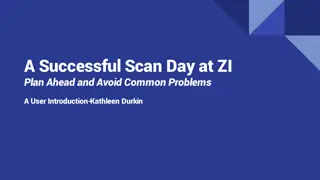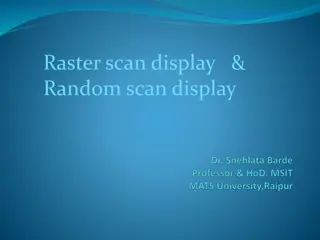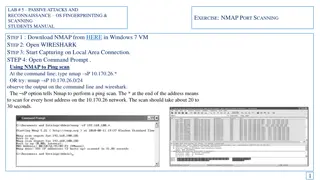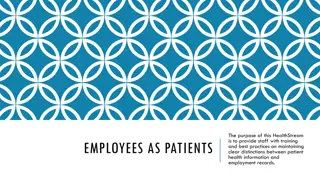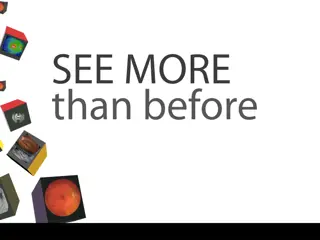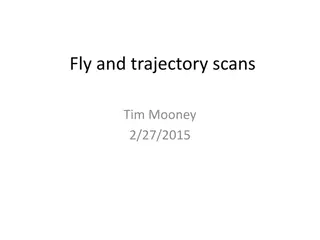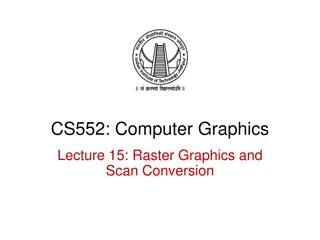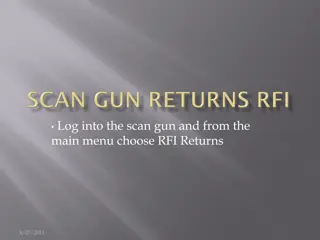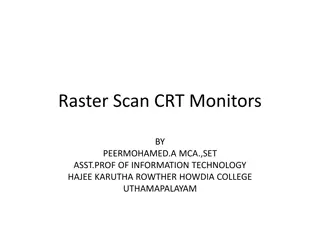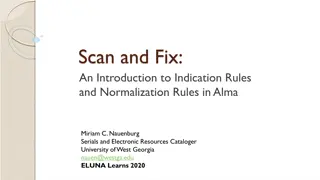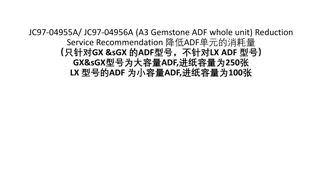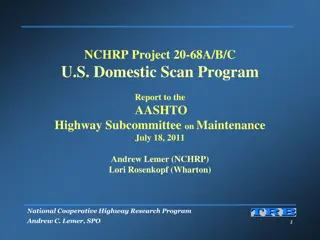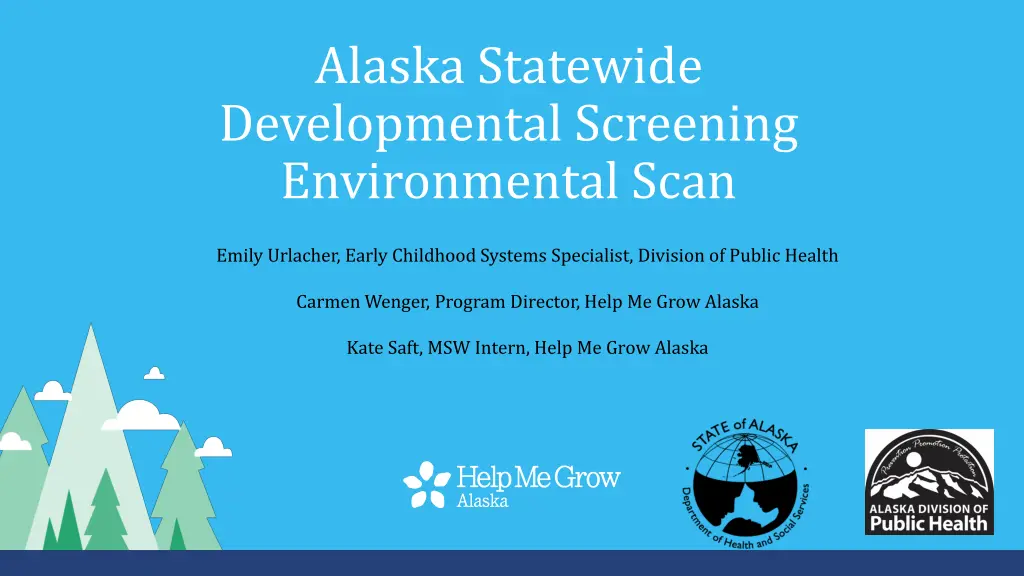
Insights from Alaska Statewide Developmental Screening Environmental Scan
Explore the outcomes and objectives of the Universal Developmental Screening Advisory Committee in Alaska, based on the recent environmental scan findings. Learn about the efforts to enhance developmental screening efficiency, data sharing, stakeholder input, and family-focused education. Discover how various agencies and organizations in Alaska are involved in developmental screening initiatives.
Download Presentation

Please find below an Image/Link to download the presentation.
The content on the website is provided AS IS for your information and personal use only. It may not be sold, licensed, or shared on other websites without obtaining consent from the author. If you encounter any issues during the download, it is possible that the publisher has removed the file from their server.
You are allowed to download the files provided on this website for personal or commercial use, subject to the condition that they are used lawfully. All files are the property of their respective owners.
The content on the website is provided AS IS for your information and personal use only. It may not be sold, licensed, or shared on other websites without obtaining consent from the author.
E N D
Presentation Transcript
Alaska Statewide Developmental Screening Environmental Scan Emily Urlacher, Early Childhood Systems Specialist, Division of Public Health Carmen Wenger, Program Director, Help Me Grow Alaska Kate Saft, MSW Intern, Help Me Grow Alaska
Presentation Objectives 1. Attendees will learn about the purpose and proposed outcomes of the statewide Universal Developmental Screening Advisory Committee (UDSAC) 2. Attendees will learn about the results of the new statewide developmental screening environmental scan. 3. Attendees will learn how the scan will support and guide the work of the UDSAC over the next few years. HelpMeGrowAK.org
Universal Developmental Screening Advisory Committee (UDSAC) Aims of the UDSAC Developmental Screening in Alaska Streamline efforts to maximize efficiency Coordinate data sharing Ensure access to training on developmental screening and screening tools Provide stakeholder input on the statewide ASQ Online system Increase family-focused education on developmental screening HelpMeGrowAK.org
Background 2017 Alaska Developmental Screening Survey An environmental scan of standardized developmental screenings birth to eight years old was conducted via survey in 2017 by Help Me Grow Alaska with the Governor s Council on Disabilities and Special Education Task Force on Developmental Screening. This was the first time statewide, multi-disciplinary data regarding screenings had been collected. HelpMeGrowAK.org
Q3. What Type of Agency/Organization Do You Work For? (select all that apply) (N=158) 22.8% Early Childhood Education/Child Care Provider 19.0% Tribal Health Organization/Clinic 16.5% School District (including preschool) 11.4% Private Health Care Provider 10.8% Early Head Start/Head Start 11.4% Early Intervention/Infant Learning Program 7.0% Other 3.8% Community Health Centers 2.5% Hospital Based Program* 2.5% Nurse Family Partnership/PAT/Other Home Visiting 1.9% Public Health Nursing Percent of Respondents
Q4. Does your agency have a mandate to conduct developmental screening? (N=156) No 48.1% 51.9% Yes
Q5. Is your agency a covered entity for data sharing/privacy laws? (N=154) 44.2% 22.7% Percent of Respondents 18.2% 9.7% 5.2% No HIPAA FERPA Both HIPAA and FERPA Unable to answer
Q6. What region(s) of Alaska does your local office/agency serve? (select all that apply) (N=155) 36.1% Percent of Respondents 16.8% 16.1% 12.3% 11.0% 11.0% 6.5% HelpMeGrowAK.org
Q7. What are the populations served through this agency? (select all that apply) (N=155) 90.3% 88.4% 85.2% 76.1% 74.2% 73.5% 68.4% Percent of Respondents 9.0% Alaska Native Low Income Ages 3-5 Birth to 3 Rural Ages 5+ Military Other Populations HelpMeGrowAK.org
Q8. Are you using an American Academy of Pediatrics (AAP) endorsed developmental screening tool? (N=155) Yes 39.4% No 60.6%
Q8. Are you using an American Academy of Pediatrics (AAP) endorsed developmental screening tool? (N=52) Medical Clinics using AAP endorsed screening tool 88.5% HelpMeGrowAK.org
Q8A: If no, please identify barriers to using a developmental screening tool (select all that apply) (N=57) 71.9% Not a requirement 45.6% Lack of training 24.6% Lack of training on ASQ Online System 15.8% Other 15.8% Cost considerations 14.0% Not enough time 5.3% Difficulty integrating with existing data system 3.5% Difficulty accessing the ASQ Online System HelpMeGrowAK.org
Q9. Related to child development, which standardized developmental screening tool(s) does your agency/organization use? (select all that apply) (N=88) 92.0% Ages and Stages Questionnaire 3 (ASQ-3) 12.5% Other: DIAL 8.0% Survey of Wellbeing of Young Children (SWYC) 6.8% PEDS 5.7% Other: Social Emotional Tool 3.4% Other: Misc. 3.4% PEDS:DM Percent of Respondents HelpMeGrowAK.org
Q9. Related to child development, which standardized developmental screening tool(s) does your agency/organization use? (select all that apply) (N=46) Medical Clinics using ASQ-3 87.0% HelpMeGrowAK.org
Q10. At what age do developmental screenings begin in your agency/organization? Assuming no parental and/or developmental surveillance concern. (N=87) 28.7% 26.4% 26.4% Percent of Respondents 16.1% 1.1% 0.0% Other Under 9 months 9 months 18 months 30 months Based on Enrollment As Needed HelpMeGrowAK.org
Q11. What is the frequency of screening? (select all that apply) (N=87) As Needed 40.2% The AAP/Bright Futures pediatric 26.4% At each well child check 26.4% At or within 45 days of enrollment 19.5% As specified by the screening tool 9.2% Within 90 days of enrollment 3.4% Other 3.4% Other: School Year Schedule 2.3% Other: Child Find 2.3% Percent of Respondents HelpMeGrowAK.org
Q12. What format is used for screenings? (select all that apply) (N=88) 90.9% Percent of Respondents 39.8% 10.2% 2.3% Paper Copy Online/Parent Access Direct entry into Electronic Medical Record (EMR) Other HelpMeGrowAK.org
Q13. Where are screenings usually conducted? (select all that apply) (N=87) 51.7% 36.8% 36.8% Percent of Respondents 18.4% 16.1% 14.9% 1.1% HelpMeGrowAK.org
Q14. Who is usually present when the screening is conducted? (select all that apply) (N=87) 89.7% Percent of Respondents 33.3% 32.2% Parent/Primary caregiver Teacher/Child Care Provider Clinician or other related providers (mental health or health care) HelpMeGrowAK.org
Q15. When screening results show no concern, what follow-up occurs? (select all that apply) (N=85) Provide the parent/primary caregiver with education and developmentally appropriate activities 56.5% 10.6% Refer for developmental assessment/evaluation 4.7% Request secondary/selective developmental screening at the next interval 32.9% Targeted developmental monitoring based on individual need 58.8% Screen at the next interval 16.5% No Follow Up HelpMeGrowAK.org
Q16. When screening results are borderline, what follow- up occurs? (select all that apply) (N=85) Provide the parent/primary caregiver with education and developmentally appropriate activities 76.5% 36.5% Refer for developmental assessment/evaluation 25.9% Request secondary/selective developmental screening at the next interval 62.4% Targeted developmental monitoring based on individual need 54.1% Screen at the next interval 1.2% No Follow Up HelpMeGrowAK.org
Q17. When screening results show areas of concern, what follow-up occurs? (select all that apply) (N=85) Provide the parent/primary caregiver with education and developmentally appropriate activities 74.1% 89.4% Refer for developmental assessment/evaluation 28.2% Request secondary/selective developmental screening at the next interval 57.6% Targeted developmental monitoring based on individual need 27.1% Screen at the next interval 0.0% No Follow Up HelpMeGrowAK.org
Q18. Are primary caregivers given the option to decline the developmental screening? (N=85) 17.6% Yes No 15.3% 67.1% I'm Not Sure HelpMeGrowAK.org
Q19. Are primary caregivers asked if another developmental screening has been completed previously before completing a new developmental screening? (N=84) Yes 36.9% No 63.1%
Q20. Does your agency/organization conduct developmental screening if the child already has an identified developmental delay? (N=84) Yes 15.5% No 20.2% 64.3% We don t ask if the child already has an identified developmental delay before conducting the screening
Q21. Does your agency/organization bill for developmental screening? (N=82) Yes 29.3% No 70.7% HelpMeGrowAK.org
Q21A: What billing codes does your agency use for developmental screening (include a modifier code if used)? (N=24) 70.6% 52.9% 47.1% 11.8% Medicaid Private Insurers Tricare Medicare HelpMeGrowAK.org
Q21B. What barriers exist that prevent you for billing Medicaid for developmental screening? (N=58) 6.9% Not set up to bill Medicaid 15.5% Clinical Setting/Unsure Not answered 53.4% 24.1% Not eligible HelpMeGrowAK.org
Contact Information Emily Urlacher, emily.urlacher@alaska.gov Carmen Wenger, carmen@a2p2.com Kate Saft, kgsaft@alaska.edu HelpMeGrowAK.org

